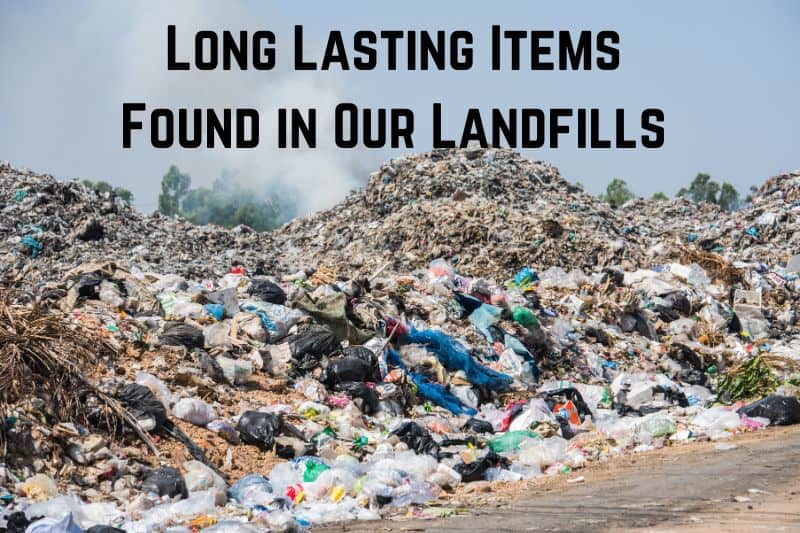Our landfills are filled with items that take an incredibly long time to decompose. The amount of waste we produce has been increasing steadily over the years, and it’s important to be aware of our consumption habits’ impact on the environment. In this article, we will be discussing the 17 longest-lasting items in our landfills.
Some of the items on this list may come as a surprise. For example, did you know disposable diapers can decompose up to 450 years? Other items on the list, such as plastic bottles and aluminum cans, are more commonly known for their long-lasting properties.
Regardless of whether you are familiar with these items, it’s important to understand their impact on the environment and what we can do to reduce our waste.
17 Longest Lasting Items Found in Our Landfills
1. Plastic Bags
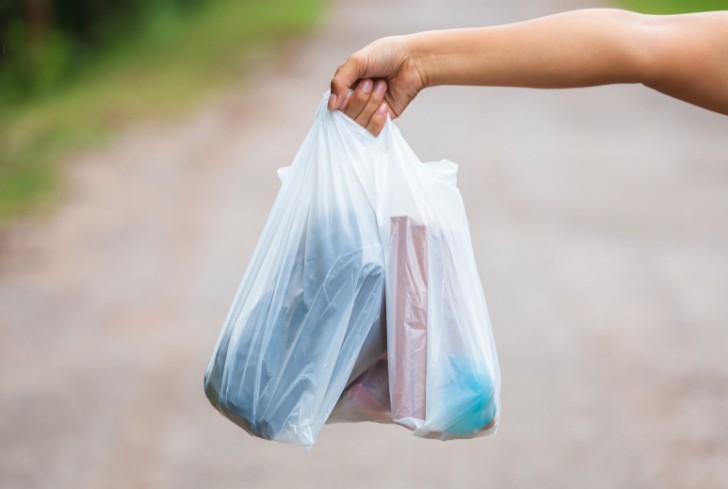
Plastic bags are common in landfills and take a long time to break down. Plastic bags can decompose anywhere from 200 to 500 years.
This is because plastic bags are made from polyethylene, a material that is not biodegradable. Instead, it breaks down into smaller and smaller pieces, eventually becoming microplastics that can harm wildlife and the environment.
One way to reduce the amount of plastic bags in landfills is to use reusable bags instead. Reusable bags are made from materials like cotton or canvas and can be used repeatedly.
Many stores now offer reusable bags, and some even offer discounts for bringing your own bag. By using reusable bags, we can help reduce the amount of plastic waste in our landfills and protect the environment.
Another way to reduce the amount of plastic bags in landfills is to recycle them. Many grocery stores and other retailers have recycling bins for plastic bags; some even accept other types of plastic film, like bread bags or produce bags. By recycling plastic bags, we can give them a second life and prevent them from ending up in landfills.
2. Plastic Bottles
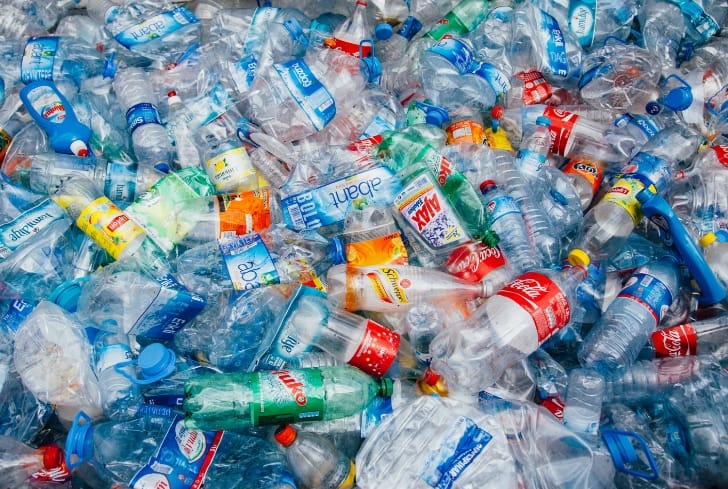
Plastic bottles are one of the most common items found in landfills. They are made of polyethylene terephthalate (PET) plastic, which can take hundreds of years to break down completely.
The recycling rate of PET bottles and jars was 29.1 percent in 2018, according to the US Environmental Protection Agency (EPA). This means that the majority of plastic bottles still end up in landfills.
One of the main reasons for the low recycling rate is the difficulty separating different plastic types. For example, a bottle cap may be made of a different type of plastic than the bottle itself, making it harder to recycle. Additionally, plastic bottles that are contaminated with food or other substances cannot be recycled.
Despite the challenges, there are ways to reduce the number of plastic bottles in landfills. One option is to switch to reusable water bottles made of stainless steel or glass. Another option is to buy products in bulk and use refillable containers instead of single-use plastic bottles.
| Material | Time to break down in a landfill |
|---|---|
| PET Plastic (used in most plastic bottles) | Hundreds of years |
3. Aluminum Cans
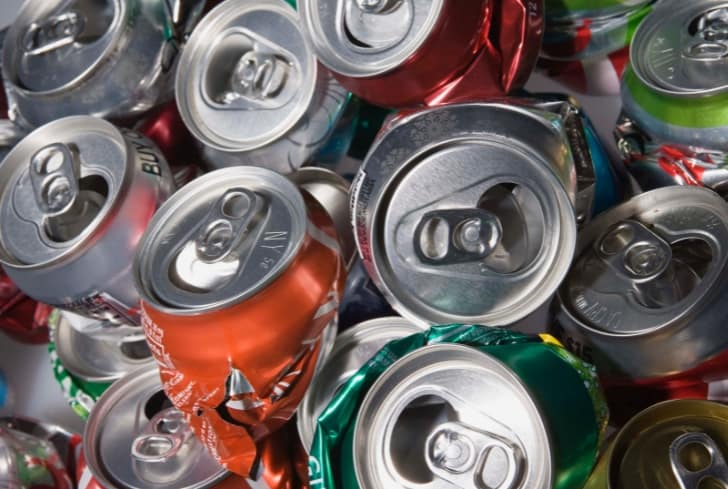
Aluminum cans are among the most commonly used packaging materials for beverages and other products. Unfortunately, they are also one of the longest-lasting items in our landfills. According to the US Environmental Protection Agency (EPA), aluminum cans can break down completely from 80 to 200 years.
Despite their long lifespan, aluminum cans are also one of the most recyclable materials. In fact, aluminum cans are the most recycled beverage container in the world, with a recycling rate of nearly 50 percent in the United States alone. This is largely due to the fact that aluminum can be recycled infinitely without losing quality or purity.
Recycling aluminum cans not only reduces the amount of waste in landfills but it also helps conserve natural resources. According to the EPA, recycling just one aluminum can save enough energy to power a TV for three hours.
Additionally, recycling aluminum cans reduces greenhouse gas emissions, as producing new aluminum from recycled cans requires 95 percent less energy than producing aluminum from raw materials.
| Time to Break Down | Recycling Rate |
|---|---|
| 80-200 years | Nearly 50 percent in the US |
4. Glass Bottles
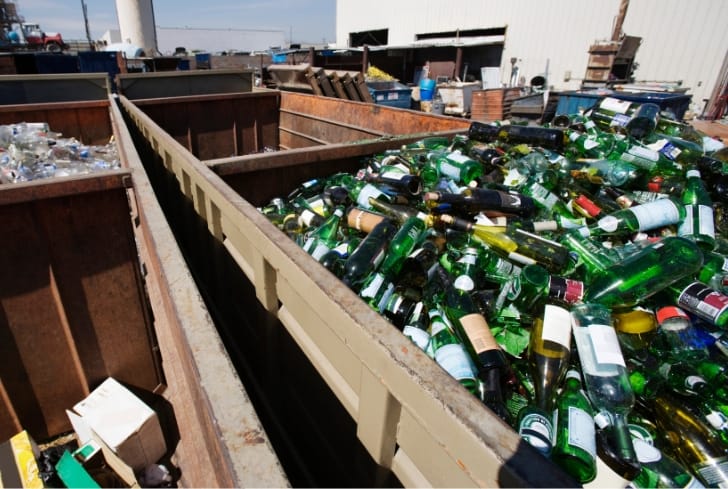
Glass bottles are one of the most common items found in landfills. According to the Environmental Protection Agency (EPA), glass can decompose in landfills for up to 1 million years. This is because glass is not biodegradable and does not break down easily. Glass can remain in landfills for centuries without decomposing.
One of the reasons glass bottles take so long to decompose is that they are not exposed to sunlight. Sunlight can help break down materials in the landfill, but since glass is not transparent, it does not allow sunlight to penetrate through it. This means that glass bottles will remain in the landfill for a very long time.
Another reason why glass bottles take so long to decompose is because they are heavy. This means they do not break down easily and can remain intact for a very long time. Glass bottles can also take up a lot of space in the landfill, which can be a problem since landfills are already running out of space.
5. Disposable Diapers

Disposable diapers are one of the most common items found in landfills. According to the US Environmental Protection Agency, an estimated 20 billion disposable diapers are added to landfills annually, creating about 3.5 million tons of waste.
Disposable diapers are made of plastic, wood pulp, and absorbent polymers. Because of the mix of materials and the addition of human waste, they are very hard to recycle.
In 2018, the estimated generation of disposable diapers was 4.1 million tons, 1.4 percent of total MSW generation that year. Disposable diapers represent about 4% of solid waste and are the third-largest single consumer item in landfills, discarded after a single use. These disposals pose a great burden on landfills.
While biodegradable and compostable diaper options are available, they are still not widely used. Additionally, there is debate over whether they are truly more environmentally friendly than traditional disposable diapers.
6. Styrofoam

Styrofoam is a type of plastic foam that takes a very long time to decompose in landfills. According to estimates, it can take anywhere from a few years to as much as 1 million years depending on the environmental conditions. This means that Styrofoam can remain in landfills for centuries, if not millennia before it finally breaks down.
One of the main reasons why Styrofoam takes so long to decompose is that it is not biodegradable. This means that the microorganisms in the soil cannot break it down into its basic components. Instead, Styrofoam remains intact and takes up valuable space in landfills, which are already filling up at an alarming rate.
Another reason why Styrofoam is such a problem in landfills is that it is very lightweight. This means that the wind can easily carry it away, ending up in rivers, lakes, and oceans. Once in the water, Styrofoam can harm marine life by being mistaken for food or by entangling animals.
| Item | Time to Break Down |
|---|---|
| Styrofoam | A few years to as much as 1 million years |
Styrofoam is a material that is still widely used in packaging even though it is harmful to the environment. Fortunately, there are alternatives to Styrofoam that are biodegradable and more environmentally friendly.
For example, companies can use paper or cardboard packaging instead of Styrofoam, which can be recycled or composted. By making these small changes, we can reduce the amount of waste in landfills and protect the environment for future generations.
7. Tires

Tires are one of the most common items found in landfills worldwide. This is because they are difficult to recycle and take up a lot of space. Tires are made of rubber and other materials that are not biodegradable, which means they will not break down over time. A tire can decompose in a landfill for hundreds of years.
However, there are ways to reduce the number of tires in landfills. One way is to recycle them. Tires can be shredded and used as fuel in cement kilns or as a component in road construction. They can also be turned into other products, such as rubber mulch for playgrounds or athletic fields.
Extending their lifespan is another way to reduce the number of tires in landfills. This can be done by properly maintaining and using tires for as long as possible. Regularly checking tire pressure, rotating tires, and balancing them can help tires last longer. Additionally, using retreaded tires can also help extend their lifespan.
Reducing the number of tires in landfills is important for the environment. By recycling and extending the lifespan of tires, we can reduce the amount of space they take up in landfills and reduce the pollution they create.
8. Batteries

Batteries are some of the most common items found in landfills. Depending on the battery type, they can decompose anywhere from 100 to 1000 years. When batteries are not recycled properly, they can release toxic chemicals into the environment and contaminate the soil and groundwater.
Some of the most common types of batteries found in landfills include:
- Alkaline batteries – These batteries can take up to 100 years to decompose. They contain chemicals such as manganese and zinc, which can be harmful to the environment if not disposed of properly.
- Nickel-cadmium batteries – These batteries can take up to 500 years to decompose. They contain toxic chemicals such as cadmium and nickel, which can leach into the soil and water if not disposed of properly.
- Lithium-ion batteries – These batteries can take up to 1000 years to decompose. They contain toxic chemicals such as lithium, cobalt, and nickel, which can be harmful to the environment if not disposed of properly.
It is important to recycle batteries properly to prevent them from ending up in landfills. Many cities and towns have recycling programs for batteries, and some electronics stores also offer battery recycling services. By properly disposing of batteries, we can help protect the environment and reduce the amount of waste in landfills.
9. Electronics
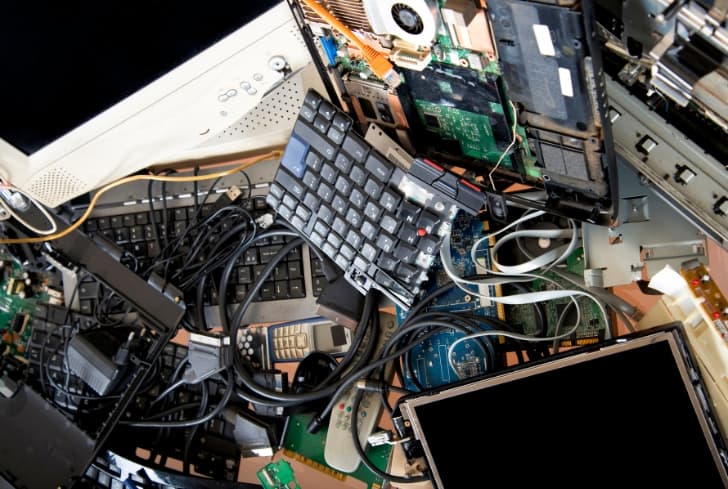
Electronic waste, or e-waste, is a growing concern for our environment. Many electronics contain hazardous materials that can leach into the soil and water if not disposed of properly. Additionally, electronics can take hundreds of years to decompose in landfills. Here are some of the longest-lasting electronics in our landfills:
| Item | Time to Break Down |
|---|---|
| Rechargeable batteries | 500-1,000 years |
| Computer monitors | 50 years |
| Cell phones | 1,000 years |
| Printers | 450 years |
| Televisions | 50 years |
Rechargeable batteries are commonly found in many electronic devices, including laptops, cell phones, and cameras. These batteries can decompose in landfills for 500 to 1,000 years. This is because they contain heavy metals that can harm the environment if not disposed of properly.
Computer monitors and televisions are also long-lasting items in our landfills, taking up to 50 years to decompose. These electronics contain lead and other hazardous materials that can contaminate the soil and water if not disposed of properly.
Cell phones are another common electronic item that can take up to 1,000 years to decompose in landfills. This is due to the materials used in their construction, including plastic and metals.
Printers are another long-lasting electronic item in our landfills, taking up to 450 years to decompose. These electronics contain hazardous materials such as lead and mercury, which can be harmful to the environment if not disposed of properly.
10. Clothing and Textiles

Textiles, including clothing and bedding, are a major contributor to landfills. According to the US Environmental Protection Agency (EPA), the recycling rate for all textiles was 14.7 percent in 2018, with only 2.5 million tons recycled.
Within this figure, EPA estimated that the recycling rate for textiles in clothing and footwear was 13 percent based on information from the American Textile Recycling Service. The rate for items such as sheets and pillowcases was 15.8 percent in 2018.
Fast fashion is a significant contributor to textile waste. Americans alone throw away an estimated 11.3 million tons of textile waste each year, equivalent to 85% of all textiles. This is around 81.5 pounds (37 kilograms) per person annually and around 2,150 pieces per second countrywide.
Synthetic fibers in many fast-fashion items are non-biodegradable, and the parts of clothing that decompose in landfills generate methane, thus contributing to climate change. The dyes and chemicals used to manufacture textiles can contaminate groundwater and soil.
Clothing and textiles can take a long time to decompose in landfills. Natural fibers such as cotton and wool can decompose up to five months, while synthetic fibers such as polyester can take up to 200 years.
| Item | Time to Break Down |
|---|---|
| Cotton clothing | 5 months |
| Wool clothing | 1-5 years |
| Leather shoes | 25-40 years |
| Synthetic shoes | 50-80 years |
| Synthetic clothing | Up to 200 years |
11. Furniture
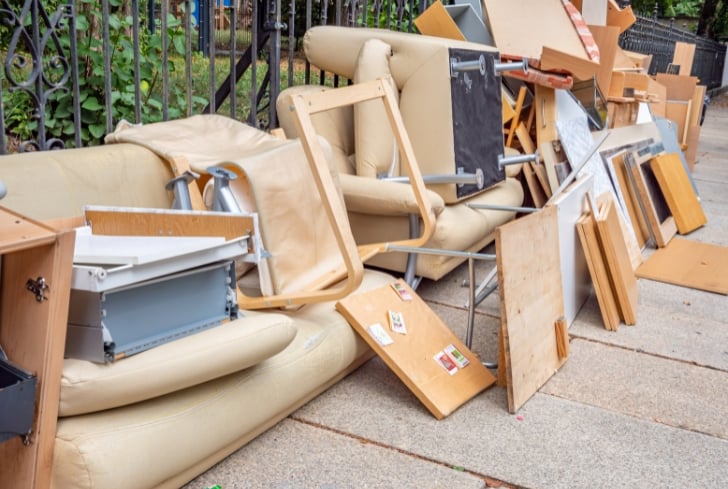
Most furniture is made from materials that take a long time to decompose, so it’s no surprise that furniture pieces are often found in landfills. Here are some of the longest-lasting furniture items:
- Particleboard: Made from wood chips and resin, particleboard can decompose up to 20 years.
- Upholstered furniture: Upholstered furniture often contains synthetic materials that can take decades to break down.
- Mattresses: Mattresses are made from various materials, including foam, cotton, and metal springs, and can take up to 20 years to decompose.
- Plastic furniture: Plastic furniture can take up to 500 years to decompose.
- Wood furniture: Depending on the type of wood, it can take a few years to several decades to decompose.
It’s important to properly dispose of furniture to prevent it from ending up in landfills. Consider donating furniture that is still in good condition or repurposing it for a new use. Additionally, choosing high-quality, durable furniture can help reduce the amount of furniture that ends up in landfills.
12. Construction Materials
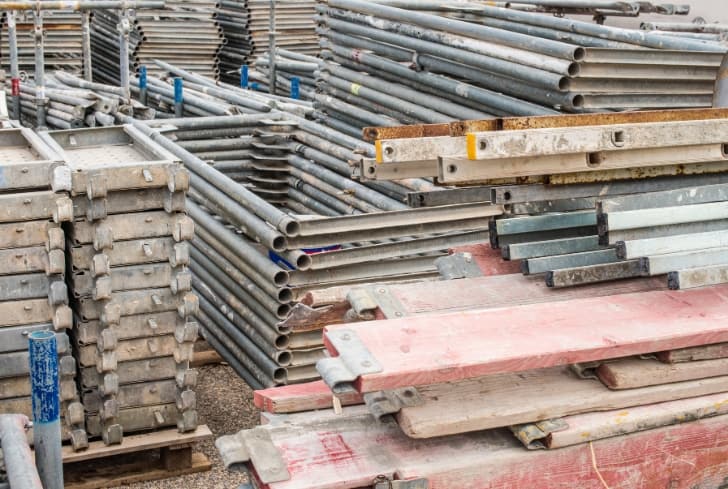
Construction materials are some of the most common items found in landfills. Depending on their composition and how well the landfill is managed, these materials can take years or even decades to decompose. Here are some of the longest-lasting construction materials found in landfills:
| Material | Approximate Decomposition Time |
|---|---|
| Plastic | Up to 1,000 years |
| Glass | Up to 1 million years |
| Aluminum cans | Up to 500 years |
| Steel | Up to 500 years |
| Concrete | Up to 500 years |
Plastic is one of the most common construction materials found in landfills. It can take up to 1,000 years to decompose, and even then, it may only break down into smaller pieces. Glass is another long-lasting material, with an estimated decomposition time of up to 1 million years.
Aluminum cans, steel, and concrete are also commonly found in landfills. While they may not take as long to decompose as plastic or glass, they can still take hundreds of years to break down. Steel, for example, can take up to 500 years to decompose, while concrete can take just as long.
It’s important to note that the decomposition times listed here are estimates and can vary depending on various factors. The actual decomposition time of these materials may be longer or shorter than what is listed here.
13. Food Waste

Food waste is a major contributor to landfills, taking up more space than any other material. In 2018, about 24% of municipal solid waste (MSW) was food. That’s equivalent to about 35 million tons of food waste in landfills.
The largest component of food waste is dairy products, with fruits and vegetables coming in second. Americans waste about 30-40% of their food supply, equivalent to about $218 billion annually. This waste not only takes up space in landfills but it also contributes to greenhouse gas emissions and wasted resources.
Reducing food waste can significantly impact the environment and the economy. By being mindful of food purchases and consumption, individuals can help reduce the amount of food waste that ends up in landfills.
Additionally, composting food scraps can help divert waste from landfills and create nutrient-rich soil for gardening and farming.
14. Single-use Cutlery

Single-use cutlery, which includes plastic forks, knives, and spoons, is a common item found in landfills due to its widespread use and disposal after just one use. These items are typically made from non-biodegradable materials, such as plastic, and take hundreds of years to break down.
As a result, they contribute to the growing problem of plastic pollution and harm the environment and wildlife. Additionally, the production of single-use cutlery requires significant energy and resources, further exacerbating its negative impact on the planet.
15. Plastic Straws

Plastic straws are common in landfills due to their widespread use and disposal after just one use. These straws are typically made from non-biodegradable materials, such as plastic, and take hundreds of years to break down.
As a result, they contribute to the growing problem of plastic pollution and harm the environment and wildlife. Additionally, producing plastic straws requires significant energy and resources, further exacerbating their negative impact on the planet.
Many individuals and businesses now opt for more sustainable alternatives, such as reusable metal, glass, or bamboo straws to reduce their environmental footprint.
16. Disposable Wet Wipes
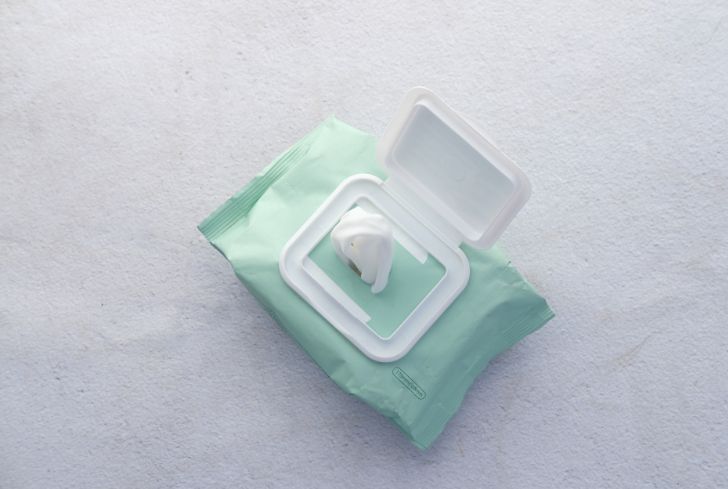
Disposable wet wipes are common in landfills due to their widespread use and disposal after just one use. These wipes are typically made from non-biodegradable materials, such as plastic fibers, and take a long time to break down.
As a result, they contribute to the growing problem of plastic pollution and harm the environment and wildlife. Additionally, many people flush wet wipes down the toilet, causing blockages in sewage systems and polluting waterways.
Many individuals and businesses are now opting for more sustainable alternatives, such as reusable cloth wipes, to reduce their environmental footprint.
17. Paper Coffee Cups
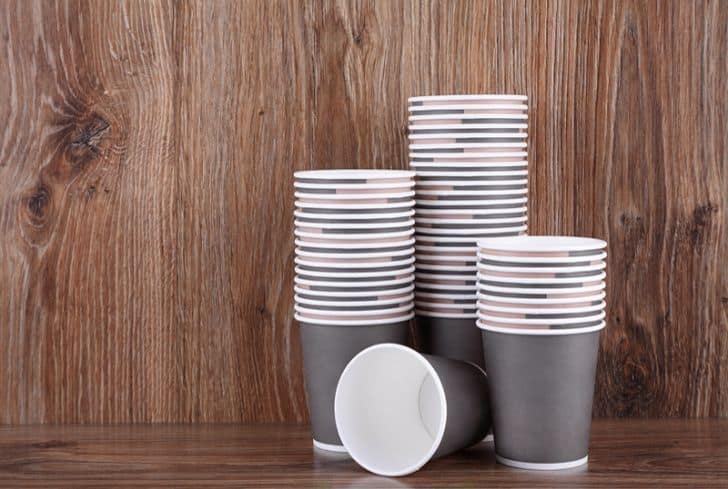
Paper coffee cups are common in landfills due to their widespread use and disposal after just one use. These cups are typically lined with a thin layer of plastic to prevent leaks, making them difficult to recycle. As a result, they contribute to the growing problem of waste and pollution.
Additionally, producing paper cups requires significant energy and resources, further exacerbating their negative impact on the planet.
Many individuals and businesses are now opting for more sustainable alternatives, such as reusable coffee cups made from materials like ceramic or stainless steel, to reduce their environmental footprint.
Conclusion
Individuals and businesses need to take action to reduce their waste and properly dispose of items that cannot be recycled or reused. This can include composting food waste, using reusable bags and containers, and properly disposing of hazardous materials.
While some items on the list, such as glass and aluminum cans, can be recycled and reused, others, such as disposable diapers and plastic bags, are more difficult to dispose of responsibly. Educating ourselves and others on these items’ disposal methods is important.
